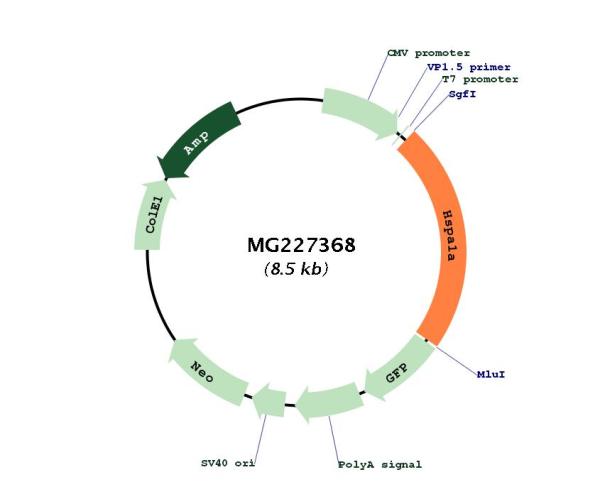Hspa1a (NM_010479) Mouse Tagged ORF Clone
CAT#: MG227368
- TrueORF®
Hspa1a (tGFP-tagged) - Mouse heat shock protein 1A (Hspa1a), (10ug)
ORF Plasmid: DDK
Lentiviral Particles: DDK w/ Puro mGFP w/ Puro
"NM_010479" in other vectors (4)
Specifications
| Product Data | |
| Type | Mouse Tagged ORF Clone |
| Tag | TurboGFP |
| Symbol | Hspa1a |
| Synonyms | hsp68; Hsp70-3; Hsp70.3; hsp70A1; Hsp72 |
| Vector | pCMV6-AC-GFP |
| E. coli Selection | Ampicillin (100 ug/mL) |
| Mammalian Cell Selection | Neomycin |
| Sequence Data |
>MG227368 representing NM_010479
Red=Cloning site Blue=ORF Green=Tags(s) TTTTGTAATACGACTCACTATAGGGCGGCCGGGAATTCGTCGACTGGATCCGGTACCGAGGAGATCTGCC GCCGCGATCGCC ATGGCCAAGAACACGGCGATCGGCATCGACCTGGGCACCACCTACTCGTGCGTGGGCGTGTTCCAGCACG GCAAGGTGGAGATCATCGCCAACGACCAGGGCAACCGCACGACCCCCAGCTACGTGGCCTTCACCGACAC CGAGCGCCTCATCGGAGACGCCGCCAAGAACCAGGTGGCGCTGAACCCGCAGAACACCGTGTTCGACGCG AAGCGGCTGATCGGCCGCAAGTTCGGCGATGCGGTGGTGCAGTCCGACATGAAGCACTGGCCCTTCCAGG TGGTGAACGACGGCGACAAGCCCAAGGTGCAGGTGAACTACAAGGGCGAGAGCCGGTCGTTCTTCCCGGA GGAGATCTCGTCCATGGTGCTGACGAAGATGAAGGAGATCGCTGAGGCGTACCTGGGCCACCCGGTGACC AACGCGGTGATCACGGTGCCCGCCTACTTCAACGACTCTCAGCGGCAGGCCACCAAGGACGCGGGCGTGA TCGCCGGTCTAAACGTGCTGCGGATCATCAACGAGCCCACGGCGGCCGCCATCGCCTACGGGCTGGACCG GACCGGCAAGGGCGAGCGCAACGTGCTCATCTTCGACCTGGGGGGCGGCACGTTCGACGTGTCCATCCTG ACGATCGACGACGGCATCTTCGAGGTGAAGGCCACGGCGGGCGACACGCACCTGGGAGGGGAGGACTTCG ACAACCGGCTGGTGAGCCACTTCGTGGAGGAGTTCAAGAGGAAGCACAAGAAGGACATCAGCCAGAACAA GCGCGCGGTGCGGCGGCTGCGCACTGCGTGTGAGAGGGCCAAGAGGACGCTGTCGTCCAGCACCCAGGCC AGCCTGGAGATCGACTCTCTGTTCGAGGGCATCGACTTCTACACATCCATCACGCGGGCGCGGTTCGAAG AGCTGTGCTCAGACCTGTTCCGCGGCACGCTGGAGCCCGTGGAGAAGGCCCTGCGCGACGCCAAGATGGA CAAGGCGCAGATCCACGACCTGGTGCTGGTGGGCGGCTCGACGCGCATCCCCAAGGTGCAGAAGCTGCTG CAGGACTTCTTCAACGGGCGCGACCTGAACAAGAGCATCAACCCGGACGAGGCGGTGGCCTACGGGGCGG CGGTGCAGGCGGCCATCCTGATGGGGGACAAGTCGGAGAACGTGCAGGACCTGCTGCTGCTGGACGTGGC GCCGCTGTCGCTGGGCCTGGAGACTGCGGGCGGCGTGATGACGGCGCTCATCAAGCGCAACTCCACCATC CCCACCAAGCAGACGCAGACCTTCACCACCTACTCGGACAACCAGCCCGGGGTGCTGATCCAGGTGTACG AGGGCGAGAGGGCCATGACGCGCGACAACAACCTGCTGGGGCGCTTCGAACTGAGCGGCATCCCGCCGGC GCCCAGGGGCGTGCCACAGATCGAGGTGACCTTCGACATCGACGCCAACGGCATCCTGAACGTCACGGCC ACCGACAAGACCACCGGCAAGGCCAACAAGATCACCATCACCAACGACAAGGGCCGCCTGAGCAAGGAGG AGATCGAGCGCATGGTGCAGGAGGCCGAGCGCTACAAGGCCGAGGACGAGGTGCAGCGCGACAGGGTGGC CGCCAAGAACGCGCTCGAATCCTATGCCTTCAACATGAAGAGCGCCGTGGAGGACGAGGGTCTCAAGGGC AAGCTCAGCGAGGCTGACAAGAAGAAGGTGCTGGACAAGTGCCAGGAGGTCATCTCCTGGCTGGACTCCA ACACGCTGGCCGACAAGGAGGAGTTCGTGCACAAGCGGGAGGAGCTGGAGCGGGTGTGCAGCCCCATCAT CAGTGGGCTGTACCAGGGTGCGGGTGCTCCTGGGGCTGGGGGCTTCGGGGCCCAGGCGCCCAAGGGAGCC TCTGGCTCAGGACCCACCATCGAGGAGGTGGAT ACGCGTACGCGGCCGCTCGAG - GFP Tag - GTTTAA >MG227368 representing NM_010479
Red=Cloning site Green=Tags(s) MAKNTAIGIDLGTTYSCVGVFQHGKVEIIANDQGNRTTPSYVAFTDTERLIGDAAKNQVALNPQNTVFDA KRLIGRKFGDAVVQSDMKHWPFQVVNDGDKPKVQVNYKGESRSFFPEEISSMVLTKMKEIAEAYLGHPVT NAVITVPAYFNDSQRQATKDAGVIAGLNVLRIINEPTAAAIAYGLDRTGKGERNVLIFDLGGGTFDVSIL TIDDGIFEVKATAGDTHLGGEDFDNRLVSHFVEEFKRKHKKDISQNKRAVRRLRTACERAKRTLSSSTQA SLEIDSLFEGIDFYTSITRARFEELCSDLFRGTLEPVEKALRDAKMDKAQIHDLVLVGGSTRIPKVQKLL QDFFNGRDLNKSINPDEAVAYGAAVQAAILMGDKSENVQDLLLLDVAPLSLGLETAGGVMTALIKRNSTI PTKQTQTFTTYSDNQPGVLIQVYEGERAMTRDNNLLGRFELSGIPPAPRGVPQIEVTFDIDANGILNVTA TDKTTGKANKITITNDKGRLSKEEIERMVQEAERYKAEDEVQRDRVAAKNALESYAFNMKSAVEDEGLKG KLSEADKKKVLDKCQEVISWLDSNTLADKEEFVHKREELERVCSPIISGLYQGAGAPGAGGFGAQAPKGA SGSGPTIEEVD TRTRPLE - GFP Tag - V |
| Restriction Sites |
SgfI-MluI
Cloning Scheme for this gene
Plasmid Map

|
| ACCN | NM_010479 |
| ORF Size | 1923 bp |
| OTI Disclaimer | The molecular sequence of this clone aligns with the gene accession number as a point of reference only. However, individual transcript sequences of the same gene can differ through naturally occurring variations (e.g. polymorphisms), each with its own valid existence. This clone is substantially in agreement with the reference, but a complete review of all prevailing variants is recommended prior to use. More info |
| OTI Annotation | This clone was engineered to express the complete ORF with an expression tag. Expression varies depending on the nature of the gene. |
| Product Components | The ORF clone is ion-exchange column purified and shipped in a 2D barcoded Matrix tube containing 10ug of transfection-ready, dried plasmid DNA (reconstitute with 100 ul of water). |
| Reconstitution | 1. Centrifuge at 5,000xg for 5min. 2. Carefully open the tube and add 100ul of sterile water to dissolve the DNA. 3. Close the tube and incubate for 10 minutes at room temperature. 4. Briefly vortex the tube and then do a quick spin (less than 5000xg) to concentrate the liquid at the bottom. 5. Store the suspended plasmid at -20°C. The DNA is stable for at least one year from date of shipping when stored at -20°C. |
| Reference Data | |
| RefSeq | NM_010479.1 |
| RefSeq Size | 2798 bp |
| RefSeq ORF | 1926 bp |
| Locus ID | 193740 |
| UniProt ID | Q61696 |
| Cytogenetics | 17 18.51 cM |
| Gene Summary | Molecular chaperone implicated in a wide variety of cellular processes, including protection of the proteome from stress, folding and transport of newly synthesized polypeptides, activation of proteolysis of misfolded proteins and the formation and dissociation of protein complexes. Plays a pivotal role in the protein quality control system, ensuring the correct folding of proteins, the re-folding of misfolded proteins and controlling the targeting of proteins for subsequent degradation. This is achieved through cycles of ATP binding, ATP hydrolysis and ADP release, mediated by co-chaperones. The co-chaperones have been shown to not only regulate different steps of the ATPase cycle, but they also have an individual specificity such that one co-chaperone may promote folding of a substrate while another may promote degradation. The affinity for polypeptides is regulated by its nucleotide bound state. In the ATP-bound form, it has a low affinity for substrate proteins. However, upon hydrolysis of the ATP to ADP, it undergoes a conformational change that increases its affinity for substrate proteins. It goes through repeated cycles of ATP hydrolysis and nucleotide exchange, which permits cycles of substrate binding and release. The co-chaperones are of three types: J-domain co-chaperones such as HSP40s (stimulate ATPase hydrolysis by HSP70), the nucleotide exchange factors (NEF) such as BAG1/2/3 (facilitate conversion of HSP70 from the ADP-bound to the ATP-bound state thereby promoting substrate release), and the TPR domain chaperones such as HOPX and STUB1. Maintains protein homeostasis during cellular stress through two opposing mechanisms: protein refolding and degradation. Its acetylation/deacetylation state determines whether it functions in protein refolding or protein degradation by controlling the competitive binding of co-chaperones HOPX and STUB1. During the early stress response, the acetylated form binds to HOPX which assists in chaperone-mediated protein refolding, thereafter, it is deacetylated and binds to ubiquitin ligase STUB1 that promotes ubiquitin-mediated protein degradation. Regulates centrosome integrity during mitosis, and is required for the maintenance of a functional mitotic centrosome that supports the assembly of a bipolar mitotic spindle. Enhances STUB1-mediated SMAD3 ubiquitination and degradation and facilitates STUB1-mediated inhibition of TGF-beta signaling. Essential for STUB1-mediated ubiquitination and degradation of FOXP3 in regulatory T-cells (Treg) during inflammation. Negatively regulates heat shock-induced HSF1 transcriptional activity during the attenuation and recovery phase period of the heat shock response.[UniProtKB/Swiss-Prot Function] |
Documents
| Product Manuals |
| FAQs |
| SDS |
Resources
Other Versions
| SKU | Description | Size | Price |
|---|---|---|---|
| MC220030 | Hspa1a (untagged) - Mouse heat shock protein 1A (Hspa1a), (10ug) |
USD 657.00 |
|
| MR227368 | Hspa1a (Myc-DDK-tagged) - Mouse heat shock protein 1A (Hspa1a) |
USD 597.00 |
|
| MR227368L3 | Lenti ORF clone of Hspa1a (Myc-DDK-tagged) - Mouse heat shock protein 1A (Hspa1a) |
USD 897.00 |
|
| MR227368L4 | Lenti ORF clone of Hspa1a (mGFP-tagged) - Mouse heat shock protein 1A (Hspa1a) |
USD 897.00 |
{0} Product Review(s)
Be the first one to submit a review






























































































































































































































































 Germany
Germany
 Japan
Japan
 United Kingdom
United Kingdom
 China
China

